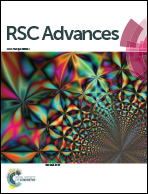Sulfonated poly(arylene thioether phosphine oxide)s (sPTPO) and sPTPO/sulfonated polybenzothiazole blends as proton exchange membranes†
Abstract
Sulfonated poly(arylene thioether phosphine oxide)s (sPTPO) were prepared, which showed high swelling at elevated temperatures. To reduce the swelling, sPTPO were blended with sulfonated polybenzothiazoles (sPBT) to prepare composite proton exchange membranes (PEMs) because the sulfonic acid groups of sPTPO and the benzothiazole moieties of sPBT can form strong acid–base interactions. Herein, sPBT were for the first time employed as a blend component to fabricate blend PEMs. The resulting blend membranes exhibited low swelling and remarkably enhanced overall properties compared to the raw sPTPO membranes. For example, one of them exhibited a swelling of only 30% even at 100 °C, a proton conductivity of 0.085 S cm−1 at 80 °C (higher than that of Nafion 117), and a methanol permeability of 1.02 × 10−7 cm2 s−1. Moreover, it also displayed excellent thermal stability, oxidative stability and mechanical properties. Therefore, sPBT are an ideal blend component to improve the resistance to swelling and the other properties of PEMs.


 Please wait while we load your content...
Please wait while we load your content...